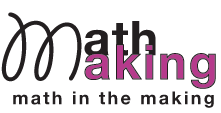Math-Enhanced Making Activities
The examples below represent the final versions of the four math-enhanced maker activities that were developed and tested at the New York Hall of Science (NYSCI) and the Children’s Museum of Pittsburgh (CMP) through the design-based research study. In different ways, each activity embodies the design principles that emerged through the research process.
Weaving Activity (CMP)
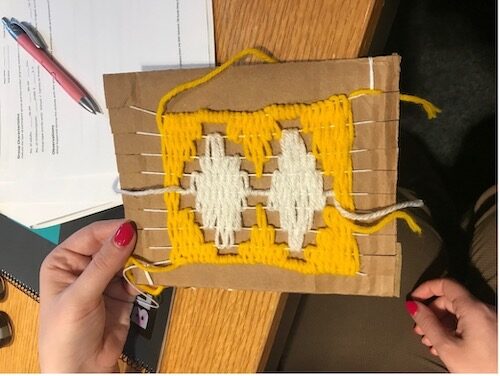
In the weaving activity chosen by the CMP team for math enhancement, visitors used cardboard looms to create simple patterns. However, the mathematical potential in weaving is more pronounced when creating non-rectangular shapes and diagonal lines. To encourage visitors to take on these design challenges, educators made examples that incorporated curves or diagonal lines. In a further step, they created non-rectangular looms, which require careful planning to determine the number of over-under pairs required for each row. A heart-shaped loom was especially popular with visitors.
Tiling Activity Kit (CMP)
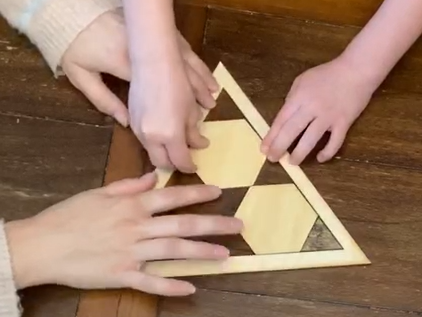
This activity was designed as a take-home kit for families during the health pandemic. It was inspired by barn quilts and popular tiling activities previously used at the museum. All these activities involve mathematical reasoning about how different geometric figures fit together based on the sizes of their angles and the lengths of their sides. The kit included a set of small, wooden tile shapes, similar to pattern blocks, colored in natural wood tones and cut to create complementary angles in increments of 30 and 45 degrees.
It also included a set of three wooden frames to encourage families to explore how the angles could be “added” to create a large angle, a mirror to support more open-ended pattern exploration, and eight challenge cards to suggest different activities with the tiles and frames (e.g., filling the frames with different combinations of shapes and angles, creating repeating patterns).
Air-Powered Vehicles Activity (NYSI)
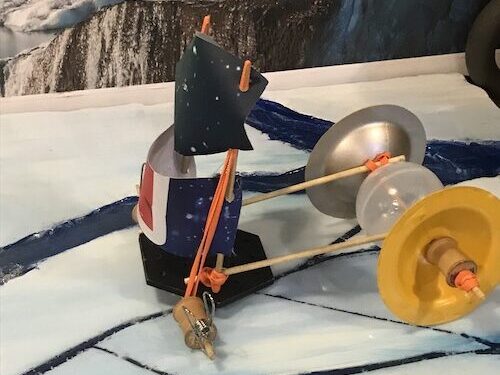
The original air-powered vehicle activity challenged visitors to build a vehicle that would be propelled to move across a surface by a fan mounted at one end of a table. There were four different surfaces on which the vehicle could travel, ranging from “ice” (very smooth) to a rough terrain with bumps and a sandy surface. Visitors used a collection of materials including several sizes of wheels, pieces of plexiglass, skewers, rubber bands, wine corks, ping pong balls, and pieces of laminated fabric. The most successful math enhancement for this activity was providing a limited set of wheel sizes that varied considerably so that visitors could observe how wheel size impacted the vehicle’s speed and its ability to navigate different terrains.
Fashion Design Activity and Mask-Making Workshop (NYSCI)
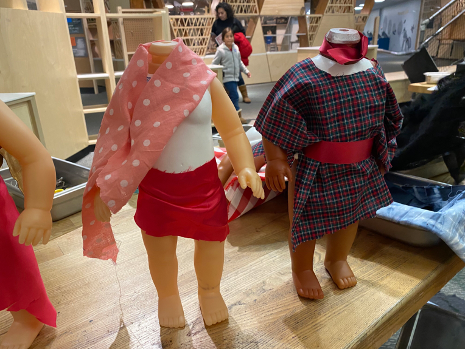
The team at NYSCI had created a math-enhanced fashion design activity that involved dress patterns and small dolls, hypothesizing that the presence of fabric patterns would inspire visitors to consider using them for the dolls’ clothes, while also signaling that there might be math involved in the process.
Unfortunately, COVID temporarily closed the museum before this activity could be prototyped. Instead, the team partnered with their community outreach colleagues to put on a virtual mask-making workshop.
Participating families received kits with everything they needed to make a mask, including a tape measure. The workshop focused on making child-sized masks, since well-fitting masks for children were hard to find at the time. Families appeared to be highly engaged in the workshop, and many seemed to draw from their prior experience sewing and making clothes. Adults also seemed more aware that “math” was involved compared to other clothing design experiences facilitated by the museum. Their math conversations seemed particularly motivated by the process of measuring specific dimensions of the face with the tape measure to ensure the mask would fit snugly, which made precise measurement more consequential.
